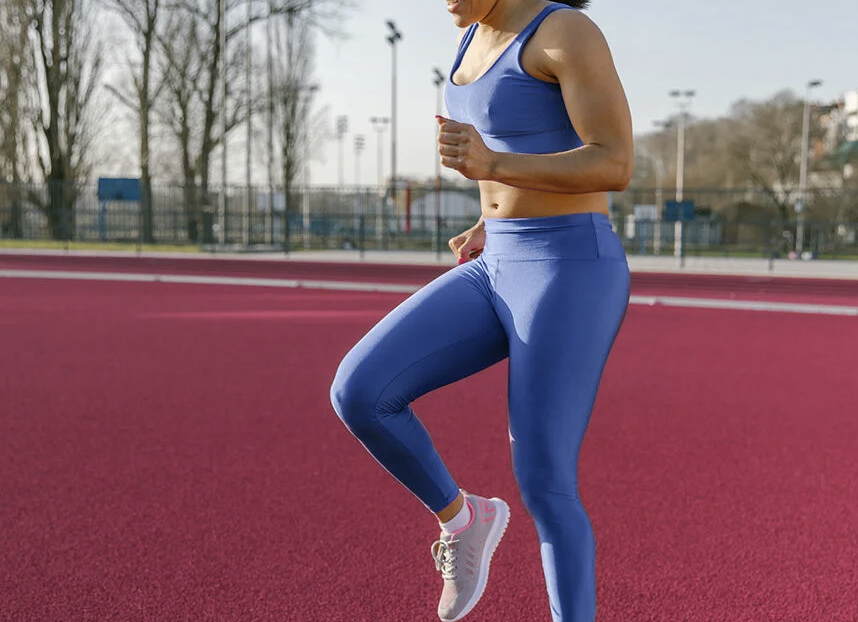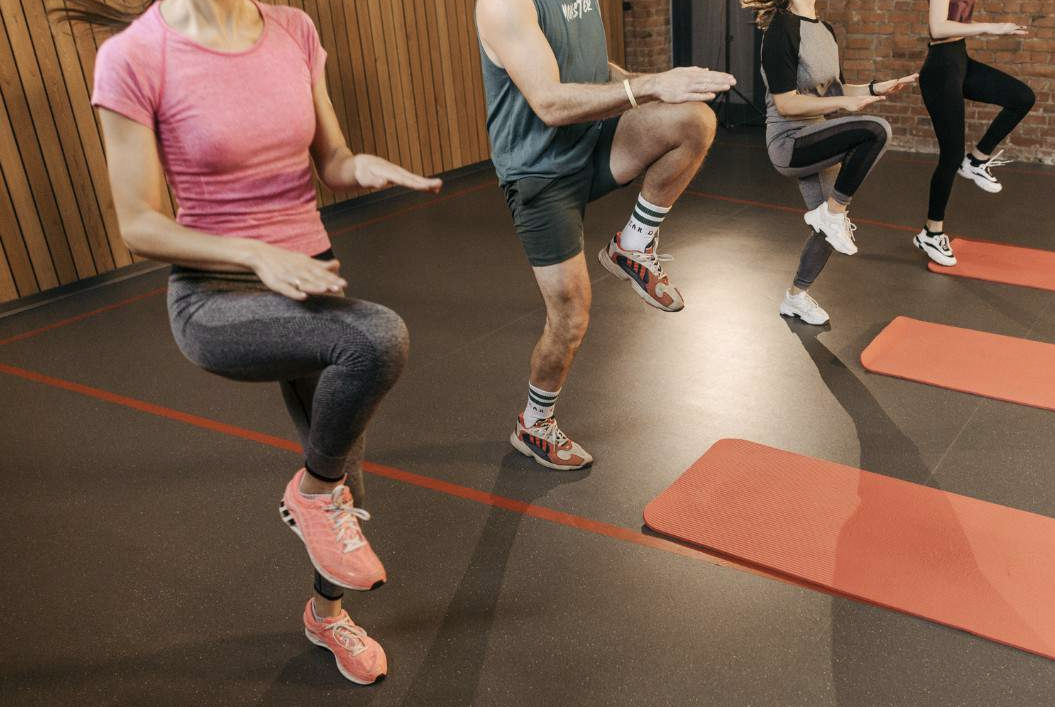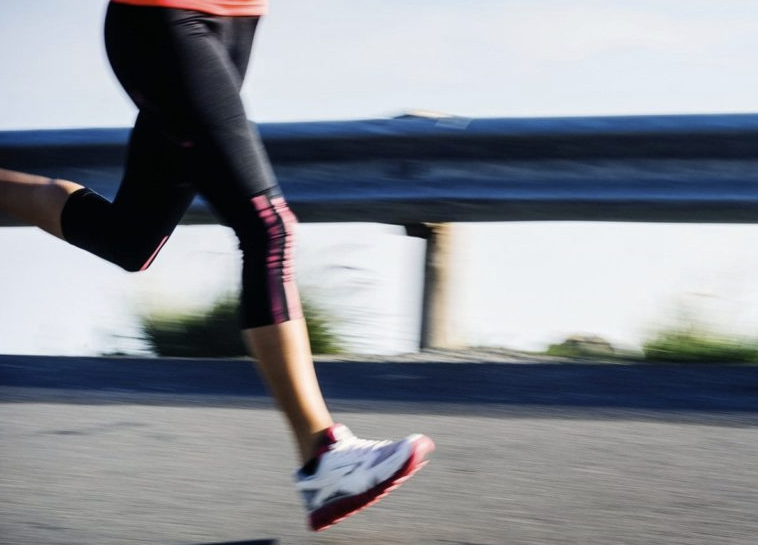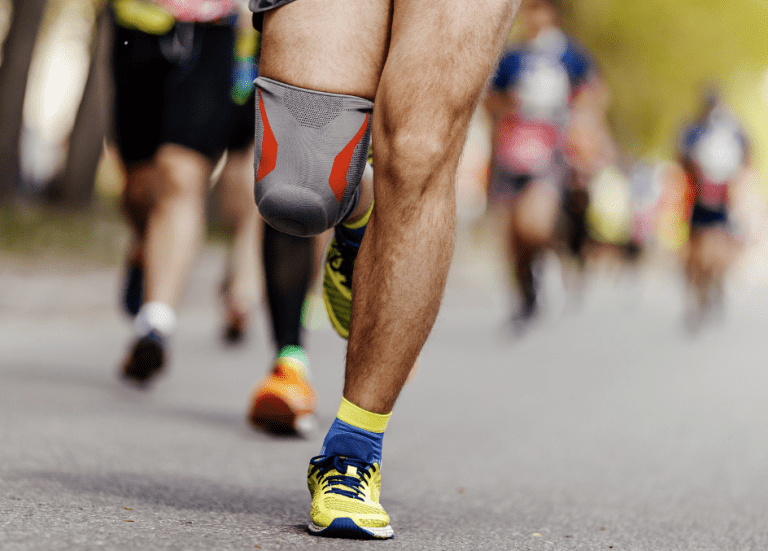This is a question many fitness enthusiasts grapple with when looking for convenient, yet impactful workouts. Jogging in place, or spot running as it’s often called, can indeed be a highly effective workout if done correctly.
This post delves into the various advantages of spot running, a popular option for fitness buffs in search of effective yet accessible workouts. We’ll explore how it engages major muscle groups and serves as an excellent aerobic workout – enhancing blood circulation and improving cardiovascular fitness.
We will also discuss techniques to enhance the intensity of your indoor runs while emphasizing the importance of maintaining good posture during these exercises. The convenience factor and potential for variation make running in place an attractive option for those seeking weight loss or overall health improvement.
From monitoring heart rate to reducing risk of fall injuries through improved balance coordination – you’ll learn why jogging in place is not just a good exercise but can be highly effective when incorporated into your regular fitness routine.
The Health Benefits of Jogging in Place
While jogging in place may not offer the same scenic views or fresh air as running outdoors, it is still an effective form of exercise. Spot-jogging indoors can be a great way to keep fit and healthy, particularly when the weather outside is less than perfect.

Engaging Major Muscle Groups Through Spot-Jogging
Jogging in place engages major muscle groups such as your quadriceps, hamstrings, glutes, and calves. It also works your core muscles, which help maintain balance and stability during the workout. These combined effects result in improved overall strength that aids daily activities like climbing stairs or carrying groceries.
Aerobic Workout Benefits from Indoor Jogging
In addition to strengthening muscles, spot-jogging provides a good aerobic workout too. Aerobic exercises, including indoor jogging, increase heart rate leading to better cardiovascular health over time. They also improve lung capacity, which translates into increased stamina for other physical activities.
Indoor jogging can help you maintain your current weight by burning calories efficiently without needing any fancy gym equipment. According to Harvard Medical School’s calorie-burning chart for different exercises (based on 30 minutes per session), a person weighing 155 pounds could burn approximately 223 calories while running at a moderate pace indoors.
This simple yet powerful exercise has more benefits than meets the eye – it improves flexibility too. The repetitive motion of lifting one foot after another stretches various leg muscles improving their flexibility over time.
Last but certainly not least; stationary runs promote mental well-being by releasing endorphins – ‘feel-good’ hormones known for relieving stress besides boosting mood significantly post-workout.
Enhancing Intensity for Effective Indoor Jogging
Jogging in place is a versatile exercise that can be easily modified to suit your fitness level and goals. To take your indoor jogging to the next level, try various techniques that will help increase intensity.
Techniques to Increase Intensity During Indoor Runs
Raising your knees higher towards your chest during each stride is one simple way to make jogging in place more challenging. This not only increases the cardiovascular demand but also engages more muscle groups, particularly those in the core and lower body. Another technique involves increasing both stride length and speed which essentially turns spot-jogging into high-intensity interval training (HIIT). You might want to check this article on how high knees help boost cardio workouts.
If you’re looking for an even greater challenge, try simulating incline running by leaning forward slightly while maintaining good posture. This requires additional effort from muscles like glutes and hamstrings hence making it a great option if toning these areas forms part of your wellness objectives. For tips on how best simulate inclines indoors without risking injury due to improper form, refer here.
Importance of Posture While Spot-Jogging
Maintaining correct posture while jogging in place is crucial not only because it helps prevent injuries but also maximizes effectiveness of each session spent sweating indoors. When performing any type of physical activity, alignment matters – shoulders should be relaxed yet straight over hips with head held high allowing easy breathing throughout entire duration of run-on-spot routines.
A common mistake people often make when trying to increase the intensity of their runs is compromising proper form leading to unnecessary strains, sprains, and other potential health issues down the line. Remember to keep your back straight, avoid slouching, and stay tight in the core for stability and balance regardless of how fast you go. Here’s an informative piece about maintaining good walking posture, which applies equally well to spot-joggers too.
Jogging in place can be made more effective by enhancing its intensity through techniques such as raising knees higher, increasing stride length and speed, and simulating incline running. Maintaining proper posture is crucial to prevent injuries and maximize the effectiveness of each session spent sweating indoors. Compromising form for intensity should be avoided to prevent potential health issues down the line.
Targeting Different Muscles through Stationary Runs
Running outdoors engages your glutes and hamstrings, but when you’re jogging in place indoors, the focus shifts. Spot-jogging targets different muscle groups like ankles and lower legs predominantly due to their increased involvement during stationary runs.
Difference Between Outdoor Running & Indoor Spot-Jogging
The main difference between outdoor running and indoor spot-jogging lies in the muscles they target. When you run outside, your body uses more of its posterior chain – that’s your glutes (butt muscles) and hamstrings (back of thighs). This happens because these muscles are responsible for propelling us forward against gravity. Runners World provides an excellent resource on how outdoor running impacts these specific muscle groups.
In contrast, when we jog in place indoors or do ‘spot-jogging’, it’s our calves (lower leg muscles) and ankle stabilizers that get a workout. These smaller yet significant muscle groups work harder as they constantly adjust to keep us balanced while we lift our feet off the ground without moving forward.
Focus on Ankle & Lower Leg Strength with Stationary Jogs
Jogging in place can be an effective way to strengthen your lower legs and ankles over time. The constant lifting of one foot after another without any forward movement forces these areas into action more than usual, resulting in improved strength over time.
- Ankles: Our ankles bear most of our body weight every day; strengthening them can help prevent injuries such as sprains or strains which are common among runners.
- Lower Legs: Stronger calf muscles not only improve overall leg strength but also boost performance whether you’re walking up stairs or sprinting towards a finish line.
If building stronger calves sounds appealing then check out this guide by Healthline, which includes exercises specifically designed for enhancing calf strength.
Jogging in place can be an effective way to target different muscle groups, such as the ankles and lower legs. While outdoor running engages the glutes and hamstrings more, stationary runs can help strengthen these smaller yet significant muscles over time. Focusing on ankle and lower leg strength through spot-jogging may also help prevent injuries like sprains or strains.
Monitoring Heart Rate for Optimal Results
For optimal results, a heart rate monitor can be invaluable for serious joggers to track their progress during workouts. This handy tool allows you to keep track of your heart rate during workouts, helping you ensure that every sweat session is as effective as possible.
The Role of Heart Rate Monitors in Fitness Regimes
A heart rate monitor plays an essential role in any fitness regime. A heart rate monitor supplies up-to-date info on how strenuously your heart is operating during physical activity, enabling you to adjust the intensity of your exercise as necessary. For instance, if your heart rate is too high, it might indicate that you’re pushing yourself too hard and need to slow down. If it’s too low, you may not be pushing yourself hard enough and could benefit from upping the intensity.
Moreover, tracking your heart rate over time can give valuable insights into improvements in cardiovascular health – lower resting rates typically signify better cardiac efficiency.
Safety Measures for Beginners Starting Cardio Workouts
For beginners just starting their cardio journey with spot-jogging or other forms of exercise, safety should always come first. A gradual approach works best when introducing new physical activities into one’s routine – start slow then progressively upping intensity over time ensures optimal results without risking injury or undue strain.
- Warm-up: Always begin with warm-up exercises like light stretching or walking before diving headfirst into vigorous activity. This helps prepare muscles for intense exertion, thereby reducing the risk of injuries such as sprains and strains.
- Maintain Hydration: Staying hydrated, especially while exercising indoors where air conditioning might lead to excessive sweating and loss of body fluids, is critical to maintaining overall well-being besides preventing dehydration-related complications such as dizziness and fainting spells among others. [source]
- Cool Down: After each workout session, make sure to cool down properly by slowing your pace gradually followed by deep breathing exercises to relax your muscles and prevent sudden drops in blood pressure, which can otherwise occur with abrupt cessation of physical activity after prolonged periods of elevated heartbeat levels. [source]
The article discusses the effectiveness of jogging in place and recommends using a heart rate monitor to track your heart rate during workouts. It also emphasizes the importance of safety measures for beginners, such as warming up, staying hydrated, and cooling down properly after each workout session. Overall, monitoring your heart rate can help optimize your indoor jogging sessions while ensuring that you exercise safely and effectively.
Convenience Factor of Running-In-Place Exercises
Running-in-place is a great choice for those seeking an efficient and convenient workout. This form of exercise offers benefits ranging from improved blood sugar levels and circulation to strengthened muscles, all without requiring any special equipment or even much space.
Mixing Up Run-On-Spot Routines with Other Exercises
The beauty of spot-jogging lies in its flexibility. You can easily mix up your routine by incorporating additional exercises like jumping jacks or lunges into your run-on-spot sessions. These additions not only keep things interesting but also enhance cardiovascular health while burning extra calories simultaneously.
Beyond these physical benefits, there’s another major advantage to consider: convenience. Whether you’re at home, in the office, or on the road traveling (something we here at DaDi know quite a bit about.), running-in-place allows you to squeeze in quick ten-minute sweat sessions wherever and whenever suits you best.
This convenience factor extends beyond mere location too – with no need for gym memberships or expensive equipment, running-in-place is an incredibly accessible form of exercise. It truly embodies our blog’s ethos – Dream big about your fitness goals; Act upon them right where you are; Discover new strength within yourself; and Inspire others along the way.
Make Time for Spot-Jogging in Your Busy Schedule
Incorporating spot-jogging into your daily routine could be as simple as setting aside ten minutes during lunch break for a quick jog around the office (or rather on-the-spot.). Or perhaps getting up early morning before work starts to set your heart pumping, ensuring your day kickstarts on an energetic note. And if weather permits, why not take advantage of natural surroundings and opt for an outdoor session instead? The possibilities are endless really when it comes to this versatile form of exercising, making it an ideal choice for those leading busy lifestyles yet still keen to maintain an active and healthy lifestyle regardless of the time constraints they may face on a daily basis.
Running-in-place exercises are a convenient and effective way to improve blood sugar levels, circulation, and strengthen muscles without requiring special equipment or much space. Mixing up run-on-spot routines with other exercises like jumping jacks or lunges enhances cardiovascular health while burning extra calories simultaneously. Incorporating spot-jogging into your daily routine could be as simple as setting aside ten minutes during lunch break for a quick jog around the office or getting up early morning before work starts to set your heart pumping.
Effectiveness of Variations and Interval Training in Place
Don’t underestimate the power of indoor spot-jogging. Although it might burn fewer calories compared to an outdoor run, you can still make your indoor jog effective by incorporating variations and interval training.
Boosting Efficacy of Exercise with Variation and Interval Training
Variation is key when it comes to any exercise regimen. The same holds true for spot-jogging. By changing up your routine – whether that’s increasing speed or intensity, adding in high knees or butt kicks – you keep things interesting while challenging different muscle groups.
Interval training, on the other hand, involves alternating between high-intensity and low-intensity workout periods. This type of training not only boosts your metabolism but also improves cardiovascular fitness more effectively than steady-state cardio workouts.
To incorporate interval training into your spot-jogging routine, try this simple method: start with a 5-minute warm-up at a moderate pace followed by 30 seconds of intense running in place then slow down for a minute before repeating the cycle again. Do this for about 20 minutes and finish off with a cool-down period.
The beauty of interval training lies in its flexibility – feel free to adjust the duration and intensity according to your fitness level. Just remember that during those high-intensity intervals, push yourself as hard as possible.
Incorporating these techniques will not only boost calorie burn but also improve endurance and overall physical performance significantly making it an ideal choice for anyone wishing to shed pounds fast albeit safely.
Safety First When Starting New Fitness Regimes
If you’re new to exercising or have been inactive for some time now, always consult with a healthcare professional before starting any vigorous physical activities such as interval trainings. Once given the all-clear signal from the doctor, proceed gradually introducing cardio into daily routines starting slow then progressively upping intensity over time ensuring safety measures are adhered to strictly.
This way, even if one isn’t able to lose weight immediately through stationary jogs, they’ll definitely gain improved heart health, increased lung capacity, alongside better balance, coordination, among other benefits long term. So why wait? Start today itself and reap rewards sooner rather than later.
The article discusses the effectiveness of jogging in place and how it can be made more effective by incorporating variations and interval training. By changing up your routine, alternating between high-intensity and low-intensity workout periods, you not only boost calorie burn but also improve endurance and overall physical performance significantly making it an ideal choice for anyone wishing to shed pounds fast albeit safely.
Reducing Risk of Fall Injuries Through Improved Balance Coordination
Spot-jogging is a great exercise to reduce the risk of fall injuries. It improves balance coordination and flexibility, making it a valuable addition to any fitness regimen.
The Importance of Proper Stretching Before and After Working Out
Before you start your spot-jogging session, it’s crucial to stretch properly. This warms up your muscles and prepares them for activity, reducing the likelihood of strains or sprains. Similarly, stretching after working out can help cool down your body gradually and enhance muscle recovery.
By engaging in spot-jogging, which involves movement from the ankles, knees and hips, you can improve your balance coordination and flexibility over time. This repetitive motion can significantly boost both balance coordination and flexibility over time – two key factors known to decrease chances of accidental falls, especially among older adults.
Incorporating spot-jogging into regular workout routines not only aids weight loss but also promotes overall health and wellness long term. The convenience factor associated with indoor running allows individuals to fit quick sweat sessions within their busy schedules without having to step foot outside the house; thereby ensuring consistency maintained throughout the journey towards achieving personal fitness goals.
However, always remember: safety first. It’s important to start slow and then progressively increase intensity as stamina builds up over time – pushing too hard early on might lead to unnecessary injury, which could potentially derail progress made so far. Hence, caution is advised at all times while exercising indoors.
To sum things up: whether your aim is to lose weight or simply stay fit and healthy, incorporating stationary runs as part of your daily routine is certainly worth considering given the numerous benefits they offer besides being easy to perform anywhere, anytime, without the need for fancy gym equipment or expensive memberships.
Spot-jogging is an effective exercise to improve balance coordination and flexibility, which can reduce the risk of fall injuries. It’s important to stretch properly before and after working out, start slow, and gradually increase intensity over time. Incorporating stationary runs into daily routines can aid weight loss and promote overall health without needing fancy gym equipment or expensive memberships.
FAQs in Relation to Is Jogging in Place Effective
Is Jogging in Place Effective for Weight Loss?
Can You Lose Belly Fat by Jogging in Place?
Jogging in place can help reduce body fat, including belly fat, but targeted fat reduction isn’t possible through specific exercises alone.
Is Marching in Place a Good Exercise?
Marching in place is a low-impact exercise that improves balance, coordination, and strength while burning calories, making it perfect for beginners or those with joint issues.
Can You Jog Around the House for Exercise?
Yes, jogging around the house can provide similar benefits as spot-jogging, including increased heart rate, calorie burning, and improved cardiovascular health.
What Are Some Other Fitness Activities Besides Jogging in Place?
- Swimming
- Cycling
- Weightlifting
- Dancing
Should You Wear Specific Brands of Fitness Equipment or Apparel?
While specific brands may offer certain benefits, it’s more important to choose equipment and apparel that are comfortable, functional, and fit well.
Should You Discuss Politics or Controversial Topics in Your Fitness Blog?
It’s best to avoid politics or controversial topics in your fitness blog to keep the focus on health and wellness.
Is it Okay to Share Personal Experiences or Anecdotes in Your Fitness Blog?
Sharing personal experiences or anecdotes can make your fitness blog more relatable and engaging for readers.
Conclusion
Absolutely! It’s a great aerobic workout that improves cardiovascular fitness, burns calories, and boosts blood circulation.
Jumping squats and butt kicks are highly effective variations that can make running in place a good exercise for weight loss and improving overall health.
Not only is it a convenient place to workout, but it’s also a highly effective one that can be done anywhere, anytime.
By targeting different muscles with ankle and lower leg strength exercises, monitoring heart rate for optimal results, and improving balance coordination, you can make running in place a highly effective physical activity.
So, if you’re looking for a place to workout that offers great benefits, try jogging in place today!







